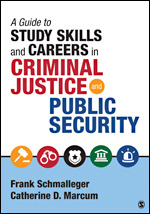A Guide to Study Skills and Careers in Criminal Justice and Public Security
- Frank Schmalleger - University of North Carolina, Pembroke
- Catherine D. Marcum - Appalachian State University, USA
Criminal Justice
A Guide to Study Skills and Careers in Criminal Justice and Public Security is the ultimate how-to resource for success in the study of criminal justice. Renowned author Frank Schmalleger, who has over 40 years of field experience, has teamed up with researcher and educator Catherine D. Marcum to introduce students to the field of criminal justice, break down its many components, and describe a variety of employment opportunities available to criminal justice graduates. Students will learn how to effectively approach the study of criminal justice; communicate successfully with professors, peers, and potential employers; choose classes that will assist with career goals; develop good study habits and critical thinking skills; and write effectively in criminal justice. Additionally, as their academic careers advance, students will gain insights into how to best prepare for successful careers.
Supplements
The open-access Student Study Site includes the following:
- Personality profile link
- Career profile boxes highlight descriptions of careers, duties, requirements, and annual salaries
- Career videos that detail a variety of professions in the criminal justice field
- Worksheets focusing on internships, personal time, professionalism, distractions, and career aspirations
- Sample cover letter
- Sample resume
“Concise, Informative without being “dry”, flows easily, and easy to read.”
“Good layout including the Table of Contents.”
“[Strengths include] the ease of reading and length of the chapters, material is relevant, and it covers topics that most CRJ students will be faced with.”
“Love the down to earth examples and writing style. It portrays reality well. Sets clear expectations on all the topics with great examples.”
“[Strengths include] the organization of the narrative in each chapter, the case studies provided, the discussion questions at the end of each chapter.”
